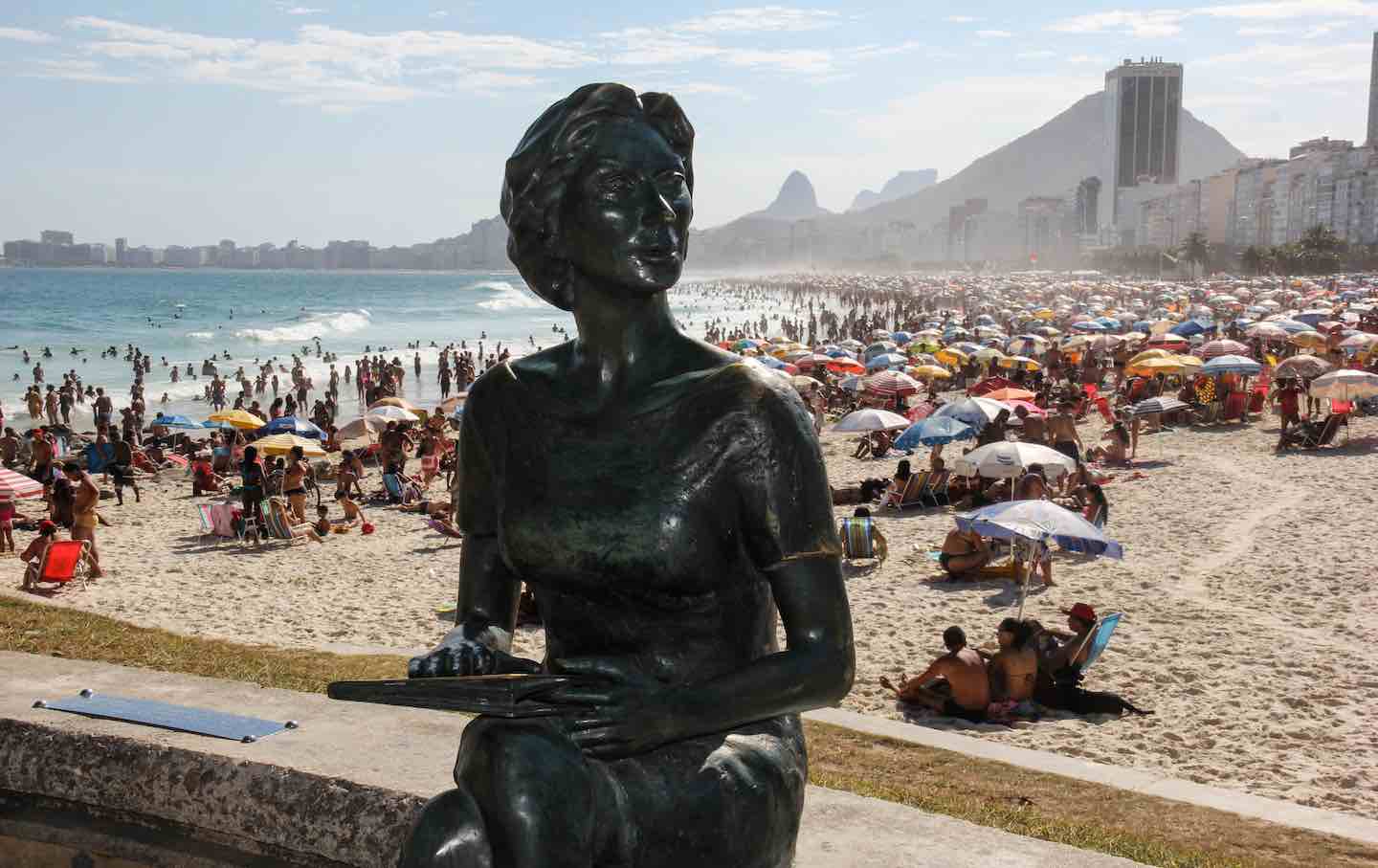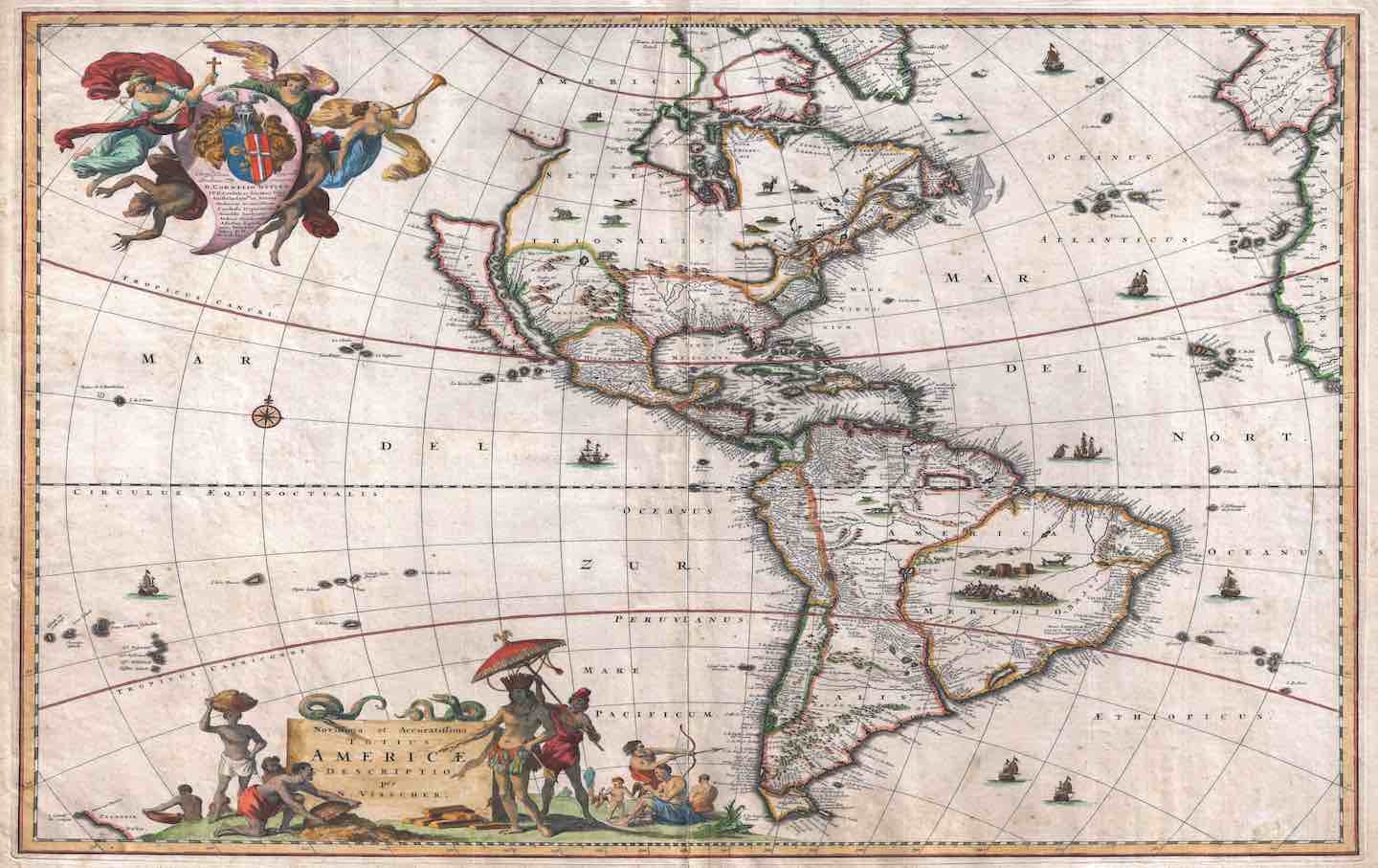Clarice Lispector’s Cosmology
To understand the philosophical dimensions of her fiction you must read her 1961 novel The Apple in the Dark.

Statue of Clarice Lispector at Leme Beach in Rio de Janeiro, 2016.
(Photo by Luiz Souza / NurPhoto)
Like dangerous talismans, Clarice Lispector’s novels stage unholy communions—between human and cockroach, reason and madness—that plunge readers further and further into “the incommunicable kingdoms of spirit.” Born in Ukraine, but forced to flee with her family to Brazil at age 12, Lispector—born Chaya Pinkhasivna Lispector—is now a beacon of global modernism. Yet more than a decade into the revival of her work, which comprises nearly 20 novels, short stories, and even children’s books, she continues to defy interpretation. What makes her work sui generis—incomprehensible, inscrutable, and compulsively rereadable—is its chief contradiction: Instead of exalting the inner life, like most works of modernism, her work evacuates it.
Books in review
The Apple in the Dark
Buy this bookThat project has captured readers since Near to the Wild Heart (1943) established Lispector as a literary force at age 23. Yet the middle of her literary career has largely escaped notice. The publication of The Apple in the Dark (1961)—translated into English from Portuguese by her biographer, Benjamin Moser—addresses that lacuna. The novel does not scaffold Lispector’s later novels so much as provide their most maximal, and most human, expression. It may not tremor with as much energy as her other work, but its place in her bibliography captures a vital artistic interregnum. Between her precocious early hits and her signature late style is the novel that would gestate a key axiom of Lispector’s project: Progress of any kind—literary, spiritual, personal—is equivalent to paring down, curbing excess, and pursuing the most elegant shape of a form. Ironically, it is this novel, her longest, that makes that point.
Unlike its offspring in The Passion According to G.H. (1964) and Água Viva (1973), The Apple in the Dark reveals the source of Lispector’s lifelong quest for the primordial. Its epigraph hails from the Upanishads, a series of oral inquiries into the origins of consciousness transmitted across several centuries BCE in South Asia. That is why, in part, she called this novel “the best one”—it is the most transparent about the philosophical journey that her later fictions repeatedly traverse: getting over yourself. It does so by jettisoning the façade of the social, and even the “authentic” self, for the timeless one of Brahman—that is, God. Of course, The Apple in the Dark is not the first work of modernism to draw upon ancient Indian philosophy. T.S. Eliot’s The Wasteland is well-known for the Upanishadic Sanskrit of its last lines—“shantih, shantih, shantih”—and the likes of Ralph Waldo Emerson, Ernst Cassirer, Arthur Schopenhauer, Leo Tolstoy, Simone Weil, Walt Whitman, and W.B. Yeats were equally drawn to its cosmology.
While ancient Indian philosophy invigorates the work of these writers and thinkers, at times, during its historical and cultural voyages, it has fallen into less ethical hands. Infamously, Nazi Indologists justified genocide through the Bhagavad Gita. More commonly, these texts have simply endured cultural misunderstandings. In Occidentosis (1962), a contemporary of The Apple in the Dark, Jalal Al-e Ahmad mocked the global vogue for Asian philosophy as a form of spiritual dandyism. Inevitably, as ideas travel, texts get used and abused.
But Lispector’s oeuvre is proof of the salutary side of cultural colloquy. Her interest in Indian philosophy reshapes our understanding of her broader novelistic project. Her work has long been framed within the mystical Christian and Jewish traditions of her Ukrainian heritage and Brazilian setting; Moser in fact reads The Apple in the Dark as an allegory of the Kabbalah. But Lispector’s oracular utterances have a source centuries older: the Taittiriya Upanishad, whose invocation of Brahman begins The Apple in the Dark: “By creating all things, he entered into everything. By entering into all things, he became whatever has form and whatever is formless.” The language of the Upanishads seeps into Lispector’s vatic syntax and paradoxical koans—discovering form through the loss of form, passing through what one is not in order to discover what one is, in the true spirit of the philosophical dialectic.
What to make of the revelation of Lispector’s ancient Indian source? Lispector neither transcribes nor updates the Upanishads. Yet she would not have viewed those charges as insults. Her work, after all, avers the novelty of imitation. Despite her famous modesty—“I lack culture and erudition”—the likes of Spinoza and Nietzsche were on the tip of her tongue. The importance of these sources to Lispector reshapes her image as a glamorous, self-taught mystic, nudging readers instead toward the philosophical substance of her characters’ quests for truth. Viewed this way, Lispector’s work sheds light, old and new, onto a perennial inquiry into our mental luminosity—and into the surprising politics that follow.
Lispector wrote The Apple in the Dark over a decade, apparently while listening to Brahms’s Symphony No. 4 on repeat. “I remember very much the pleasure I felt writing The Apple in the Dark,” she said, according to her son, in a passage that mimics the earnest style of her characters. “Every morning I typed. I copied it eleven times to find out what I was trying to say, because I want to say something and I still don’t know for sure what. By copying I will understand myself.” Lispector finished the novel in Washington, DC, where she was living with her then-husband, a diplomat. There, she appears to have come across the work of Swami Prabhavananda and Frederick Manchester, whose English translation of the Upanishads provides the novel’s epigraph.
Unlike in Lispector’s subsequent fiction, which practically emerges from the ethereal realm of the symbol, The Apple in the Dark’s dramatis personae are somewhat more fleshed out. The plot kicks off when the protagonist, Martim, arrives at a ranch shared by two relatives, Vitória and Ermelinda. The presence of multiple characters is noteworthy in terms of Lispector’s oeuvre, but the three are best understood as a collective. Their dialogues often devolve into existential monologues. A third-person narrator, in lieu of Lispector’s typically tormented “I,” helps readers keep track of their flirtations and ruminations, which are born out of a shared sense of desperation.
Vitória and Ermelinda have made tragic bargains with life, avoiding trouble by asking for little, while Martim is on the run after supposedly murdering his wife in a crime of passion. But as the doubts into his mental state grow, we learn that his wife “hadn’t even died.” Martim’s crime—cryptically and frequently alluded to without much explanation—becomes less literal and more metaphorical over the course of the novel: As he reckons with a murder he did not actually succeed in committing, Martim does kill off his own ego.
This process takes place in three stages that correspond to the novel’s three parts. Part I, “How a man is made,” is a loose metaphysical meditation spurred by Martim’s attempted crime. Part II, “Birth of a hero,” empties Martim’s individuality into the whole of humanity. Part III, “The apple in the dark,” concludes his journey. Once the inward-looking protagonist of his own life, then the product of his philosophical dialogues with Ermelinda and Vitória, Martim, in the novel’s final act, realizes that an apple can simply sit in the dark, irrespective of our conscious awareness of it. In other words, he grasps his insignificance in a world that exists independently of him.
The journey outlined by the novel’s three parts tracks the journey of its characters toward the fundamental source of consciousness. That is the explicit reason Lispector gives for writing: “I want the thing itself.” The phrase is not mystical; it is a citation of Kant, perhaps by way of Virginia Woolf: “But there is no Shakespeare, there is no Beethoven; certainly and emphatically there is no God; we are the words; we are the music; we are the thing itself.” Lispector is after the Kantian noumenal, the Woolfian moment of being, or the Upanishadic Brahman—the timeless unity of consciousness that makes possible the world’s diversity, regardless of what you call it.
But when Lispector’s characters seek out this primordial “thing itself,” they don’t remain there. They come back to the world, ready to change it. Martim’s journey emphasizes that return leg. During a stay at the ranch, he begins to question the social codes that have led him to life as a fugitive. Dissatisfied with what passes for conventional wisdom—upheld by another invisible force, capitalism—he experiences a vision:
Suddenly it really did seem to Martim that until now he’d been traveling down superimposed paths. And that his true and invisible journey had really been made beneath the path he thought he’d been walking along. And that the true journey was now emerging suddenly into the light as from a tunnel.
Lispector would explain this insight in The Passion According to G.H.: “The gradual deheroization of oneself is the true labor one works at beneath the apparent labor.” But in The Apple in the Dark, looking inward instead of outward—in order to view both directions with lucidity—tames Martim’s tantrums. Just as G.H. lowered herself to the level of a cockroach, receiving it like a host, Martim humbles himself before the hapless Vitória, kneeling before her and inspiring her to reciprocate the gesture.
Their symbolic expression of equality produces a sense of unity. “More and more he was feeling himself to be other people,” the narrator exults. “He had reached an impersonality inside himself: he had been so deeply himself, that he had become the ‘himself.’” Martim peels back the false layers of the outer self to enter our shared humanity. In this way, he realizes the novel’s Upanishadic message, etched in its epigraph: “He became all manner of things: that is why the wise men call him the real one.”
If Martim realizes that his self (atman) is merely an expression of Brahman—that his individual consciousness is but a fraction of the universal mind to which it is identical—his author reaches the same insight: “I am Martim,” Lispector once admitted. This spiritual revelation begets a more surprising political one: “In private,” according to Lispector’s son, “she always described herself as a democratic socialist.”
How does spiritualism lead to socialism? In her work, Lispector nudges her characters toward “the delicate work” of “being objective.” Newly cognizant of how they perceive the world, they begin a quest to see reality clearly. What they behold often isn’t pretty. When Martim describes “the world undone by a crime,” he may as well be referring to the crimes of capitalism itself. The notion that Martim “could re-erect, give a meaning and set up once again,” suggests less a physical or metaphysical re-creation of the earth than the possibility of an egalitarian future.
Popular
“swipe left below to view more authors”Swipe →This interpretation is not that far-fetched. Throughout her life, Lispector asked how—if at all—literature could represent or even reduce economic equality in Brazil; she originally studied law to aid in prison reform. But her fiction arguably provides the immaterial foundation for material uplift, not through agitprop but through conceptual miracles: epiphanies. During her characters’ moments of kairos, they demonstrate how unwitting consumers of capitalist ideology can recognize—and then challenge—its logic of commodity. If an almost-murderer like Martim can flip the mental switch, readers can do it too: “Having at least reached fully himself…[Martim] would reach men,” the narrator proclaims, describing the mimetic effect of her words on the person who reads them.
This movement from self to others, inner life to outer world, and subjectivity to objectivity explains how Lispector’s enlightenment could sustain a socialist program. What compels these awakenings is the novel’s Upanishadic spirit. If her characters realize that there is a common source to us all—humans, animals, plants, consciousness, even “the thing itself”—Indian philosophy becomes less a passing fad or epigraphic decoration. Its unity consciousness instead provides the ballast for political consciousness; its universalism, the bedrock of socialism. Thus, when Lispector’s characters get over themselves, what follows isn’t simply inner peace, blithe indifference to the world, or superficial curiosity about others. Instead, they view themselves as fundamentally the same substance as others: materially, economically, ecologically, spiritually, and, in the case of Martim, even literally.
Hold the powerful to account by supporting The Nation
The chaos and cruelty of the Trump administration reaches new lows each week.
Trump’s catastrophic “Liberation Day” has wreaked havoc on the world economy and set up yet another constitutional crisis at home. Plainclothes officers continue to abduct university students off the streets. So-called “enemy aliens” are flown abroad to a mega prison against the orders of the courts. And Signalgate promises to be the first of many incompetence scandals that expose the brutal violence at the core of the American empire.
At a time when elite universities, powerful law firms, and influential media outlets are capitulating to Trump’s intimidation, The Nation is more determined than ever before to hold the powerful to account.
In just the last month, we’ve published reporting on how Trump outsources his mass deportation agenda to other countries, exposed the administration’s appeal to obscure laws to carry out its repressive agenda, and amplified the voices of brave student activists targeted by universities.
We also continue to tell the stories of those who fight back against Trump and Musk, whether on the streets in growing protest movements, in town halls across the country, or in critical state elections—like Wisconsin’s recent state Supreme Court race—that provide a model for resisting Trumpism and prove that Musk can’t buy our democracy.
This is the journalism that matters in 2025. But we can’t do this without you. As a reader-supported publication, we rely on the support of generous donors. Please, help make our essential independent journalism possible with a donation today.
In solidarity,
The Editors
The Nation








